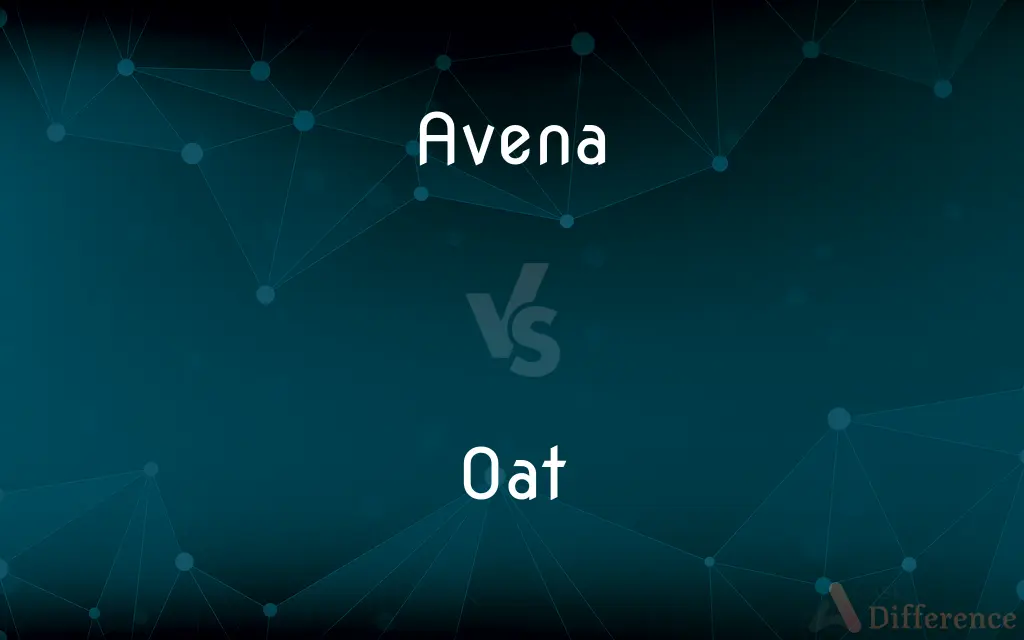Avena vs. Oat — What's the Difference?
By Urooj Arif & Fiza Rafique — Updated on March 22, 2024
Avena is the genus of plants known as oats, characterized by their cereal grain. Oat refers to the edible seeds produced by Avena species, commonly used in food.

Difference Between Avena and Oat
Table of Contents
ADVERTISEMENT
Key Differences
Avena, the genus, encompasses various species of oats, including the common oat (Avena sativa) widely cultivated for its seeds. These plants are part of the grass family and are grown in temperate regions around the world. Their growth and development depend on specific climatic and soil conditions, making the study of Avena crucial for agricultural and ecological research. On the other hand, oat refers specifically to the seed or grain harvested from these plants, which is a staple food ingredient known for its nutritional benefits, including high fiber content and a range of vitamins and minerals.
The cultivation of Avena species involves agricultural practices geared towards optimizing plant health, resistance to pests and diseases, and grain yield. Researchers and farmers may explore different Avena species to identify those most suited to local conditions, potentially improving sustainability and efficiency in oat production. In contrast, the processing of oat after harvesting involves cleaning, hulling, and sometimes roasting or rolling the grains to produce various food products, such as oatmeal, rolled oats, and oat flour, each offering distinct textures and cooking properties.
The genetic and botanical study of Avena can lead to advancements in plant breeding, including the development of new oat varieties with enhanced nutritional profiles, better yield, or increased resistance to environmental stressors. This scientific exploration is essential for agricultural innovation and sustainability. Meanwhile, the nutritional study of oat focuses on understanding how its components, like beta-glucan, contribute to human health, guiding dietary recommendations and the development of functional foods that leverage oat's healthful properties.
In terms of ecological impact, Avena species play a role in crop rotation and soil health in agricultural systems, contributing to biodiversity and the management of pests and diseases. Oat cultivation, when integrated into sustainable farming practices, can enhance soil fertility and structure, reducing the need for chemical inputs. This ecological consideration contrasts with the consumer-oriented perspective on oat, which emphasizes its dietary value and versatility in recipes ranging from breakfast dishes to baking.
Comparison Chart
Definition
Genus of plants known as oats.
Edible seeds produced by Avena.
ADVERTISEMENT
Focus
Botanical and agricultural.
Culinary and nutritional.
Application
Study of species, cultivation.
Food products, health benefits.
Importance
Genetic diversity, crop improvement.
Dietary fiber, healthful eating.
Research
Plant breeding, ecology.
Nutritional science, food technology.
Ecological Role
Crop rotation, soil health.
Sustainable farming practices.
Products
Various oat species.
Oatmeal, rolled oats, oat flour.
Compare with Definitions
Avena
Agricultural focus.
Avena species are studied for their growth, yield, and disease resistance.
Oat
Culinary versatility.
Oat is used in breakfast cereals, baking, and healthful snacks.
Avena
Genus of plants.
Avena sativa, or common oat, is widely cultivated for its grain.
Oat
Food products.
Oat is processed into oatmeal, rolled oats, and flour for various culinary uses.
Avena
Plant breeding.
Breeding efforts in Avena aim to enhance nutritional quality and resilience.
Oat
Edible grain.
Oat is valued for its nutritional content, including fiber and vitamins.
Avena
Diverse species.
Different Avena species are explored for improved agricultural practices.
Oat
Nutritional research.
Studies focus on oat’s beta-glucan and its positive effects on health.
Avena
Ecological impact.
Avena plays a role in crop rotation, improving soil health and biodiversity.
Oat
The oat (Avena sativa), sometimes called the common oat, is a species of cereal grain grown for its seed, which is known by the same name (usually in the plural, unlike other cereals and pseudocereals). While oats are suitable for human consumption as oatmeal and rolled oats, one of the most common uses is as livestock feed.
Avena
Avena is a genus of Eurasian and African plants in the grass family. Collectively known as the oats, they include some species which have been cultivated for thousands of years as a food source for humans and livestock.
Oat
An Old World cereal plant with a loose, branched cluster of florets, cultivated in cool climates and widely used for animal feed.
Avena
A genus of grasses, including the common oat (Avena sativa); the oat grasses.
Oat
An oat stem used as a musical pipe by shepherds, especially in pastoral or bucolic poetry.
Avena
Oats
Oat
Any of various grasses of the genus Avena, especially A. sativa, widely cultivated for their edible grains.
Oat
The grain of any of these plants, used as food and fodder.
Oat
A musical pipe made of an oat straw.
Oat
(uncountable) Widely cultivated cereal grass, typically Avena sativa.
The oat stalks made good straw.
The main forms of oat are meal and bran.
World trade in oat is increasing.
Oat
(countable) Any of the numerous species, varieties, or cultivars of any of several similar grain plants in genus Avena.
The wild red oat is thought to be the ancestor of modern food oats.
Oat
The seeds of the oat, a grain, harvested as a food crop.
Oat
A simple musical pipe made of oat-straw.
Oat
The tiniest amount; a whit or jot.
Oat
A well-known cereal grass (Avena sativa), and its edible grain, used as food and fodder; - commonly used in the plural and in a collective sense.
Oat
A musical pipe made of oat straw.
Oat
Annual grass of Europe and North Africa; grains used as food and fodder (referred to primarily in the plural: `oats')
Oat
Seed of the annual grass Avena sativa (spoken of primarily in the plural as `oats')
Common Curiosities
Can Avena species vary significantly?
Yes, there are various Avena species, each with unique characteristics suited to different environmental conditions and agricultural needs.
Why is oat considered a healthy food?
Oat is rich in dietary fiber, particularly beta-glucan, and contains essential vitamins and minerals.
What are oats used for?
Oats are used for food, offering nutritional benefits and versatility in cooking and baking.
What is Avena?
Avena is the botanical genus that includes various species of oats, important for agricultural and ecological studies.
How does Avena contribute to agriculture?
Avena species are studied for their potential in crop improvement, yield optimization, and ecological benefits.
What role does Avena play in the ecosystem?
Avena species can enhance soil health and biodiversity through crop rotation and sustainable farming practices.
Can Avena species be used for purposes other than food?
Yes, some Avena species are used in cover cropping and soil management strategies.
How does oat cultivation impact the environment?
Oat cultivation, especially when integrated into sustainable practices, can improve soil structure and fertility, and reduce environmental impact.
How is oat processed for consumption?
Oat grains are cleaned, hulled, and sometimes rolled or cut into smaller pieces for easier cooking and digestion.
What scientific research is being done on Avena?
Research on Avena focuses on plant breeding, disease resistance, and ecological impact.
Are all Avena species edible?
While several Avena species are cultivated for food, the common oat (Avena sativa) is the most widely consumed.
What makes oat a versatile ingredient in cooking?
Oat can be used in a wide range of recipes, from breakfast cereals to snacks and baked goods, due to its texture and nutritional profile.
What are some popular oat-based products?
Oatmeal, rolled oats, and oat flour are popular for their nutritional value and culinary use.
Share Your Discovery

Previous Comparison
Impermanent vs. Permanent
Next Comparison
Grackle vs. GrakleAuthor Spotlight
Written by
Urooj ArifUrooj is a skilled content writer at Ask Difference, known for her exceptional ability to simplify complex topics into engaging and informative content. With a passion for research and a flair for clear, concise writing, she consistently delivers articles that resonate with our diverse audience.
Co-written by
Fiza RafiqueFiza Rafique is a skilled content writer at AskDifference.com, where she meticulously refines and enhances written pieces. Drawing from her vast editorial expertise, Fiza ensures clarity, accuracy, and precision in every article. Passionate about language, she continually seeks to elevate the quality of content for readers worldwide.














































